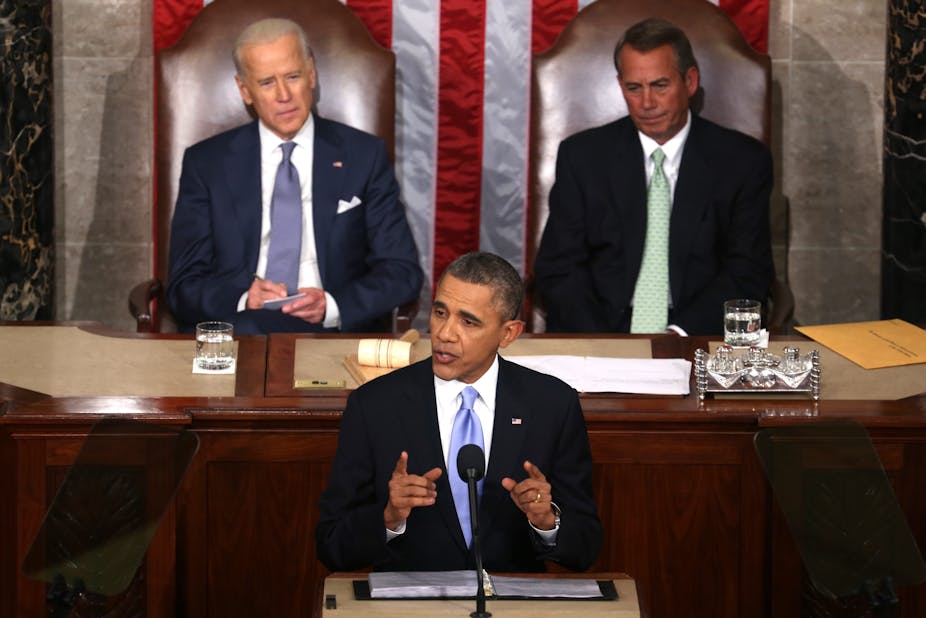US President Barack Obama is preparing to move on inequality after several long years of frustrated reform, if we are to believe his State of the Union address.
This year, according to Obama, is a “year of action”, and in his case, the year to bypass a deadlocked Congress and work toward vital policy goals.
This is the moral leadership in the fight against poverty and inequality that we need. And in his final years in office, Obama is in a unique position to provide it.
Obama said inequality was “the defining issue of our time”. It is plain that opportunity, mobility and equity are all badly stalled in a country whose democracy was built on these principles.
“Today, after four years of economic growth, corporate profits and stock prices have rarely been higher, and those at the top have never done better. But average wages have barely budged. Inequality has deepened. Upward mobility has stalled,” Obama said as he promised to do all he could without legislation.
And while Obama presented an optimistic assessment of the economic recovery of the United States, the real concern of Republican intransigence remains. Without federal investment in infrastructure, research and development, and education, inequality will not improve.
Currently around 3.3% of GDP is spent in these areas, the same amount at the end of George W. Bush’s presidency. In fact, the level of US government spending in these areas is half what it was at its peak in 1968 at 6.6% of GDP.
In the aftermath of the global financial crisis, Obama did get through a stimulus package including serious investment in education and job training, energy, transportation, and science and research. His signature achievement in health care, the Affordable Health Care Act, secured after years of guerrilla warfare with the Republican Tea Party, included US$940 billion over a decade to expand health care coverage.
But while it has removed some of the insecurity and burden of health care costs, the Obama Administration thus far has not been able to secure any relief from the inexorable slide in the earnings of American workers over recent decades.
This is the reason for Obama’s strategy for manoeuvring around a divided Congress with a series of executive actions not requiring Congressional approval.
Obama said he would issue an executive order to raise the minimum wage to $US10.10 ($A11.50) an hour from $US7.25 ($A8.26) an hour for federal contract workers under future contracts.
In his address he called on Congress to pass a bill raising the federal minimum wage for all workers to the same figure, and to index this to inflation.
Increasing US inequality
It is hard to believe how far the US has drifted toward serious inequality and absolute poverty. Despite the passage of the so-called Obamacare, those at the bottom of the pyramid of acute inequality live a desperate material existence that would not be tolerated in any other advanced industrial country.
The US Congressional Budget Office has graphically illustrated the advancing inequality in America: 80% of the US population experienced a significant decline in their relative share of income in the years 1979-2007, while the top 20% enjoyed a substantial increase.
According to the Congressional Budget Office, “between 2005 and 2007, the after-tax income received by the 20% of the population with the highest income exceeded the after tax income of the remaining 80%.”
And it is the super-rich 0.1% of the US population that have done really well in these years. Between 1981 and 2006, the percentage of all pre-tax income received by the top 0.1% rose from 2.2% to 8%.
As New York Times columnist Paul Krugman recently wrote, while accumulating all this undeserved wealth, the rich have reinvented the tawdry rationalisations of the laissez-faire Victorian era: that “the rich are enterprising and the poor lack character”. Of course what the contemporary poor lack today (as did the poor of the past) are opportunities.
Building a mountain of global inequality
As Credit Suisse’s 2013 Global Wealth Report reveals, US inequality is a central driver of a developing vast global pyramid of inequality:
Our estimates suggest that the lower half of the global population possesses barely 1% of global wealth, while the richest 10% of adults own 86% of all wealth, and the top 1% account for 46% of the total.
Median wealth is one way of measuring the distribution of wealth.
Australia leads the world with a median wealth of US$220,000 per capita, followed by Luxembourg, Belgium, France, Italy, the UK, and Japan. The US is behind almost all other advanced industrial countries, with a median wealth of just US$45,000. It is the end of the great American middle class.
At the bottom of this global mountain of inequality, half of the world’s population have assets of less than US$4,000. Then there are the hundreds of millions of people still living on $2 a day.
Moral leadership
Obama is not the first US president to draw attention to these issues. Lyndon Johnson, in his first State of the Union address in 1964, launched a “War on Poverty” to resounding effect.
His rhetoric was not as polished as Obama’s but his intentions were clear:
This administration today, here and now, declares unconditional war on poverty in America. I urge this Congress and all Americans to join with me in that effort.
It will not be a short or easy struggle, no single weapon or strategy will suffice, but we shall not rest until that war is won. The richest nation on earth can afford to win it. We cannot afford to lose it. Our aim is not only to relieve the symptom of poverty, but to cure it and, above all, to prevent it.
Let’s hope Obama takes up this war effort.

